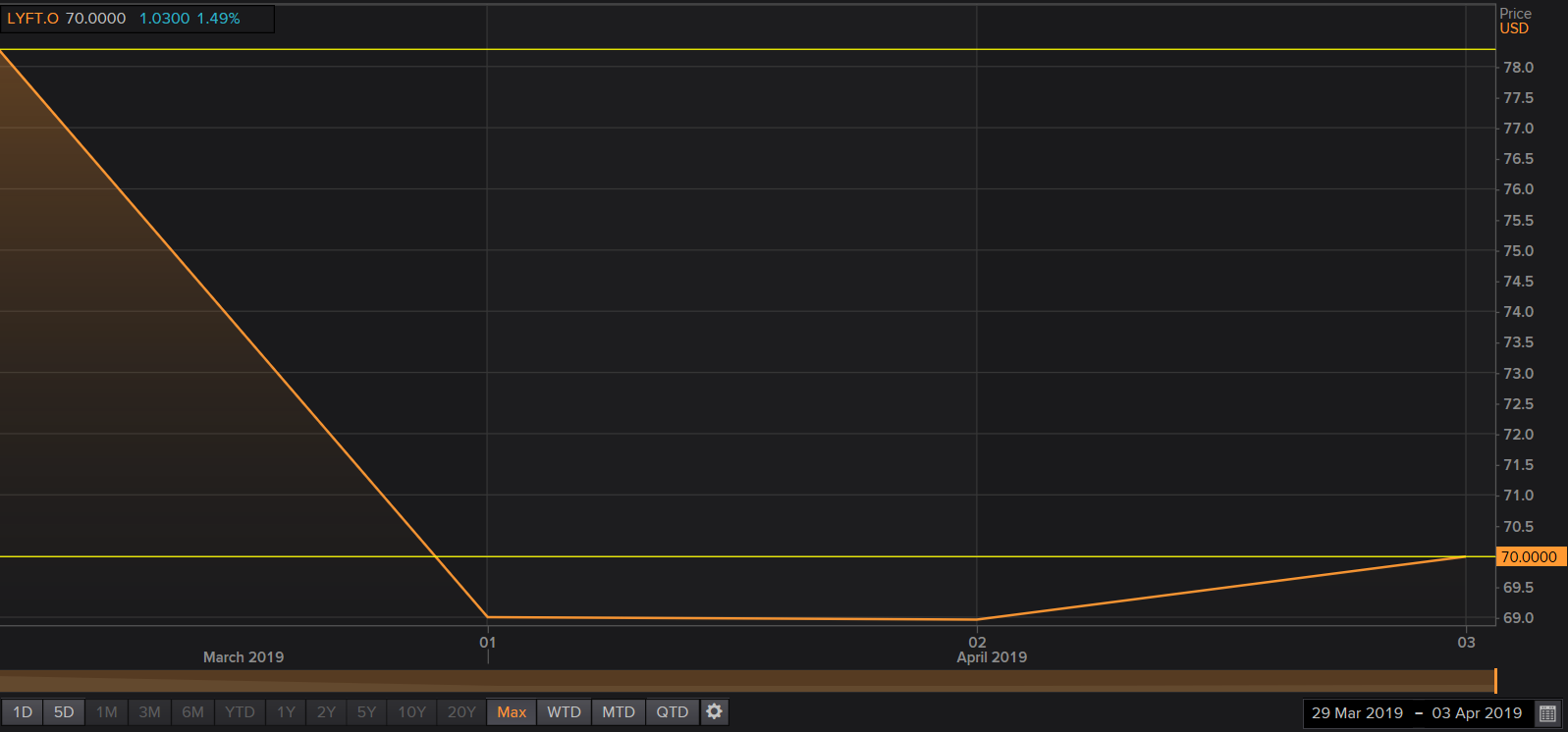
Company Overview: LYFT Inc. is an on-demand transportation-as-a-service (TaaS) provider. The Company provides peer-to-peer transportation and on-demand ridesharing platform, which offers ride-hailing services. Lyft matches drivers with passengers who request rides through its smartphone application, and passengers pay automatically through the application. The Company offers ridesharing marketplace, which connects drivers with riders to provide car sharing and transportation services. The Company also has a network of shared bikes and scooters in various cities to address the needs of riders who are looking for short trips. Its nearby transit offering integrates third-party public transit data into the Lyft app to offer riders a robust view of transportation options. It offers various enterprise programs, including monthly ride credits for daily commutes, supplementing public transit by providing rides for the first and last leg of commute trips, late-night rides home and shuttle replacement rides.
.png)
LYFT Details
Positioning for better Growth: LYFT Inc (NASDAQ: LYFT), has emerged as the second-largest transportation network company that holds 39% of the ridesharing market share in the United States. The company is now a fast-growing name across United States and Canada. The business that is based on multimodal transportation network has become popular with regards to offering transportation services to a diverse set of riders. The company provides the network of shared transportation vehicles like bikes and scooters in a lot of cities to cater to the requirements of riders for short routes, Express Drive program and car rentals, that are flexible.
.png)
Multimodal Platform (Source: Company Reports)
LYFT’s revenue growth was noted to be of the order of 209%, year-on-year basis, from 2016 to 2017; and it witnessed a growth of 103% from 2017 to 2018. The company posted topline figures of $ 343.3 million, $ 1.1 billion and $ 2.2 billion in respective years - 2016, 2017 and 2018. The bookings grew 141% from 2016 to 2017 and 76% from 2017 to 2018 ($1.9 billion, $4.6 billion and $8.1 billion in 2016, 2017 and 2018, respectively). However, the net loss amounted to $ 682.8 million, $ 688.3 million and $ 911.3 million from FY16 through to FY 18. The company currently did not project the timeline when it would turn around to profit. About 76% growth in Bookings and 17% expansion in revenue as a Percentage of Bookings supported the FY18 top line. The Bookings grew due to 65% growth in Rides, which ultimately grew due to growth in the range of 47% to 74% in Active Riders in each of the quarters of FY18 compared to the corresponding periods in FY17. The Active Riders grew on the back of an expansion in the market share and broader market adoption of ridesharing. During FY 18, there was an expansion by four percentage points to 27% in the revenue as a Percentage of Bookings against 23% of FY 17. The expansion in Revenue as a Percentage of Bookings was due to increased efficiency and effective incentives of driver, which led to about two percentage points’ rise in service fees and commissions. LYFT’s cash and cash equivalents amounted to about $ 517.7 million (as of December 31, 2018) while short-term investments were about $ 1.5 billion (excluding the restricted cash, cash equivalents and investments of $ 1.1 billion).
.png)
Financial Highlights (Source: Company Reports)
Strong User Network: LYFT is one of the largest transportation networks in the United States and Canada and its Active Riders have been 18.6 million while over 1.1 million drivers were reported during the quarter ended December 31, 2018. The base for Active Riders has expanded from 12.6 million in Q4 of 2017 to 18.6 million in Q4 of 2018 while it was 6.6 million in Q4 of 2016, depicting a year-over-year growth of 91% in FY17 and 47% in FY18. LYFT is known to have its reach across over 300 markets in the United States and Canada; and its network has expanded significantly over last few years.
.png)
Active Riders (in millions) (Source: Company Reports)
Rider Base Growth: LYFT’s rider base continues to grow as the company is investing in brand image building and increased the marketing to expand consumer awareness. The company also offers lucrative discounts for first time riders and various incentives for the company’s existing drivers and riders for references. LYFT is expanding its platform coverage to different geographies and markets.
Expansion in Multimodal Offerings: LYFT is expanding the multimodal offerings through investments in employees (like engineers, data scientists, designers etc.), investments in new and existing businesses that may lead to low margins temporarily but will significantly enhance the platform capabilities and growth in topline, and also investments in the Network of Bikes and Scooters that are shared and the development of Autonomous Technology.
M&A and Strategic Partnerships: LYFT snapped up Motivate (known to be largest bike sharing platform in the United States) in November last year and this has added to its capabilities. The company intends to pursue acquisitions selectively for better growth that includes expansion into adjacent markets and adding new features or capabilities to the platform. Moreover, the company has built strategic relationships with the transportation suppliers, state and local prevailing governments and providers of the technological solutions.
Improved Revenue as a Percentage of Bookings: There has been a significant growth in revenue as a Percentage of Bookings over a period of time based on the usage by the riders on the company’s platform, which opened opportunities for more earnings for drivers and the generation of increased service fees and commissions. Further, the company posted strong growth rate in Revenue as a Percentage of Bookings in the second and fourth quarters of FY18 as the company has risen the service fees and commissions as per rate prevailing the industry. Additionally, LYFT’s Revenue as a Percentage of Bookings is expected to move up with better utilization of hours driven, better incentives for drivers and higher revenue from network of shared bikes and scooters. Further, opportunities from Select Express Drive Partner are expected to add value.
Cut throat competition: LYFT is operating in an extremely competitive market; and has been competing effectively for further growth and improving the results of operations in order to achieve and maintain long-term profitability of the company so far. The company has tough competition from other ridesharing service offering companies like Uber, and bike and scooter sharing operators like Lime and Bird. The company is also giving stiff completion to taxi cab and livery companies, conservative manufacturers of automobiles and developers of autonomous vehicle technology that include Alphabet (Waymo). LYFT’s ridesharing market share in the United States, has moved up to 39% as at December 2018 from 22% as at December 2016. Moreover, the company has differentiated their business to get competitive edge by building a multimodal TaaS (Transportation-as-a-service) network at scale.
Use of IPO Proceeds: In the recent IPO (Initial Public Offering), the company offered about 32,500,000 shares of Class A common stock, and additional 4,875,000 shares to the underwriters (with an option to be purchased); and the Class A common stock were priced at $72.00 per share. The main purpose of the IPO was to increase the market capitalization and financial strength of the company, through proffering a market for the investors to punt on Class A common stock. The proceeds from the IPO have been indicated for use to cater to general corporate purposes (working capital use, operating expenses, capex etc.); to attain projected tax withholding, and fulfilling remittance obligations with regards to certain restricted stock units. The company may use a part of funds raised for the acquisition or for investment in businesses. Meanwhile, LYFT’s IPO served as a test case, for many highly valued startups like Pinterest Inc., Postmates Inc. and Slack Technologies Inc. that have plans to come up with an IPO this year.
Positive Industry Outlook: It is noteworthy that Transportation market has emerged as an attractive space over the years and it was the second largest segment associated with household expenditure as per 2017 statistics. Further, the consumer expenditures on transportation in the United States were about $1.2 trillion in 2017. LYFT plans to capture substantial majority of this massive market in the future. Additionally, LYFT has become a popular name among a few to have formed a TaaS network at scale across the United States, and this positions the company to be a prospective leader in the transportation segment. Thus, the group is aiming to leverage from the scenario and improve its margins and key financial ratios finding support from emerging industry landscape.
.png)
Key Ratios (Source: Company Reports and Thomson Reuters)
Stock Recommendation: The company’s stock was listed on the Nasdaq Global Select Market and touched about $87, which was 21 percent more than the IPO price but eventually had fallen below its IPO price in two days in view of aggressive short-selling activity. The company had already secured valuations of more than $1 billion from private investors. The company has posted strong growth for topline, bookings, active riders etc. year on year from past three years and same are expected to grow further. The market share for LYFT is expected to grow by 1-2% in the next one year and positive view on company’s strategy, management and value deriving methodology indicates for a better potential. Healthy cash at hand, expected double digit rise in revenues in 2019 and healthy EBITDA performance can boost LYFT’s 2019 Earnings per share while it may turn positive in few years from now. Given the growth potential, we initiate a ‘Buy’ recommendation on the stock at the current price of $ 70.00 while key risks are to be borne in mind.

LYFT Daily Chart (Source: Thomson Reuters)
Disclaimer
The advice given by Kalkine Pty Ltd and provided on this website is general information only and it does not take into account your investment objectives, financial situation or needs. You should therefore consider whether the advice is appropriate to your investment objectives, financial situation and needs before acting upon it. You should seek advice from a financial adviser, stockbroker or other professional (including taxation and legal advice) as necessary before acting on any advice. Not all investments are appropriate for all people. Kalkine.com.au and associated websites are published by Kalkine Pty Ltd ABN 34 154 808 312 (Australian Financial Services License Number 425376). The information on this website has been prepared from a wide variety of sources, which Kalkine Pty Ltd, to the best of its knowledge and belief, considers accurate. You should make your own enquiries about any investments and we strongly suggest you seek advice before acting upon any recommendation. Kalkine Pty Ltd has made every effort to ensure the reliability of information contained in its newsletters and websites. All information represents our views at the date of publication and may change without notice. To the extent permitted by law, Kalkine Pty Ltd excludes all liability for any loss or damage arising from the use of this website and any information published (including any indirect or consequential loss, any data loss or data corruption). If the law prohibits this exclusion, Kalkine Pty Ltd hereby limits its liability, to the extent permitted by law to the resupply of services. There may be a product disclosure statement or other offer document for the securities and financial products we write about in Kalkine Reports. You should obtain a copy of the product disclosure statement or offer document before making any decision about whether to acquire the security or product. The link to our Terms & Conditions has been provided please go through them and also have a read of the Financial Services Guide. On the date of publishing this report (mentioned on the website), employees and/or associates of Kalkine Pty Ltd do not hold positions in any of the stocks covered on the website. These stocks can change any time and readers of the reports should not consider these stocks as advice or recommendations.